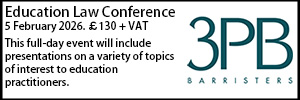Part 4 of SEN statements
- Details
 Rachel Kamm reviews recent Upper Tribunal decisions in relation to Part 4 of SEN statements.
Rachel Kamm reviews recent Upper Tribunal decisions in relation to Part 4 of SEN statements.
In MA v Borough of Kensington and Chelsea (SEN) [2015] UKUT 0186 (AAC) the Upper Tribunal considers the legal status of an ASD unit within a mainstream school.
MA’s parents wanted a particular independent school named in Part 4 of MA’s SEN statement. By definition, an independent school is not a mainstream school (with limited exceptions) and therefore section 316 of the Education Act 1996 (which, in summary, gives parents a right to a mainstream school placement) did not apply. The First-tier Tribunal found that the independent school was not suitable for MA and therefore did not name it in Part 4. The parents were refused permission to appeal against this aspect of the decision.
The First-tier Tribunal went on to consider the local authority’s proposed school. This was an ASD unit, which was set up by a mainstream primary school. The First-tier Tribunal concluded that the ASD unit was part of the mainstream primary school and therefore counted as a mainstream school placement (even though it was in a separate building from the rest of the school and there would be limited integration). The Upper Tribunal agreed. This is thought to be the first decision that has expressly found that a SEN unit within a mainstream school is a mainstream school placement as a matter of law, which is important when considering parental preferences.
The Upper Tribunal also looked at parental wishes in KC v LB Hammersmith and Fulham (SEN) [2015] UKUT 0177 (AAC). In this case, B’s parents wanted her to attend a specialist independent school. This was not a mainstream school for the purposes of section 316 of the Education Act 1996. The local authority proposed a special maintained school (also not a mainstream school). The first task for the First-tier Tribunal was to carry out the balancing exercise required by section 9 of the Education Act 1996 and to compare these two schools. It found that a placement at the parental preference specialist independent school would be unreasonable public expenditure. There was no appeal against this finding.
Once the parental first choice had been rejected, B’s parents’ second choice was a Free School, which was an independent mainstream school. The local authority did not object. However, the First-tier Tribunal found that it did not have jurisdiction to name the Free School. The Upper Tribunal found that this was an error of law.
Once the local authority had accepted that B could attend the Free School, the parents sought to resurrect the argument that the specialist independent school (their first choice) should be named. They asked the Upper Tribunal to carry out a section 9 balancing exercise, comparing the Free School and the specialist independent school. The Upper Tribunal rejected this argument. There was no need to take section 9 into account for a second time, given that the local authority now only proposed the Free School because they acknowledged the parental right to their choice of mainstream placement (once their first choice specialist independent school had been rejected by the Tribunal).
The Upper Tribunal gave this extremely helpful summary of how the legislation fits together:
“15. The sequence, it seems to me is as follows. There may be a preliminary step in some cases of considering whether it is inappropriate for the child to be educated in school: that is the gateway to making provision out of school (TM v LB Hounslow [2009] EWCA Civ 859; [2011] ELR 137). Among the reasons for considering the question are firstly that there is little point in the local authority naming a school (at any rate as sole provision) if its view is that it is inappropriate for a child to be educated in school; and further, that s316 only applies “to a child with special educational needs who should be educated in a school”(s316(1)) and thus working out whether s319 bites is logically before one can later assess whether s316 is in play.
16. In a case to which sch 27, para 3 applies and the parental preference is not defeated by either of the express conditions in that provision, then the school of preference must be named by the authority. In a case where a preference under sch 27 para 3 case has been expressed , it is only once a parent has failed under that section that one comes to consider s316: (R (MH) v Special Educational Needs and Disability Tribunal and LB Hounslow [2004] EWCA Civ 770; [2004] ELR 424).
17. In a case to which sch 27 para 3 does not apply, in exercising the discretion which s324(4) confers on an authority with regard to naming a school, as with all its powers and duties under the Education Acts, section 9 must still be applied. The result of such an exercise is a factor to which regard must be had (Hampshire CC v R and SENDIST [2009] EWHC 626 (Admin); [2009] ELR 371) but does not exclude other factors (Watt v Kesteven CC [1955] 1 QB 408 at 424.) Section 9 does not create a qualified right to the school of preference as does sch 27 para 3 but that school requires to be addressed at this point, as part of the duty to comply with s9. …
19. At that point, therefore, when the fallback preference had been triggered, a local authority wishing to persist with placement in a special school would not be able to say that placement in a mainstream school would be incompatible with the wishes of the parent for the purposes of s.316(3) (even though there would not have been such incompatibility earlier, when the parent’s preference had been for a non-mainstream school). The fallback preference could be defeated if the authority could show that a mainstream placement would be incompatible with the provision of efficient education for other children, but that is not suggested to be the case here. Therefore, given the fallback preference had been expressed and the acceptance of its validity, the local authority was bowing to the inevitable in agreeing to mainstream provision.
20. The key questions in this case are, having arrived at this point in the analysis, (a) whether section 9 has any further life and (b) if it does, how it falls to be applied. …
22. I acknowledge that the Court of Appeal in MH said that it was necessary to apply sch 27 para 3 at the outset and that that provision has no further relevance when a s316 exercise is being undertaken. It would however be in my view an over-simplification to treat sch 27 para 3 (when a qualifying preference is expressed for a maintained school) and s9 (when the preference is for a non-maintained school) as direct equivalents and from that to argue that the relevance of s9, like that of sch 27 para 3, is confined to the front end of the logical process. The former is a provision applicable within a defined procedure, which – subject to defined exemptions – cuts across other provisions so as to create rights: cf. MH at [69]). The latter merely sets out a principle to which a local authority is required to have regard, among other considerations. It also is subject to defined exemptions but its field of application is far wider (the exercise of functions under the Education Acts) and it operates outside the ambit of a defined procedure. …
28. Given the principle of the fallback preference, I cannot see that it does any violence to the language of the section to treat “the wishes of [the parent]” as encompassing first the initial preference and, once that has failed and the fallback preference been triggered, the latter preference. Consequently, where the fallback preference has been triggered, the s9 principle would fall to be applied by reference to wishes under the fallback preference, just as before the fallback preference was triggered, it fell to be applied by reference to the original preference. 29. So understood, although s9 is capable of applying at this point of the analysis, it simply has no purchase as both the parent and the authority are agreed on a particular mainstream school once, applying ss316/316A, a mainstream school has been determined to be required.”
Finally, readers may be interested in this Upper Tribunal decision, where the First-tier Tribunal’s decision was set aside because of inadequate reasons a failure to apply the correct legal test when looking at the suitability of the proposed schools: Cambridgeshire County Council v SF (SEN) [2015] UKUT 0231 (AAC).
Rachel Kamm is a barrister at 11KBW. She can be contacted on 020 7632 8500 or
































